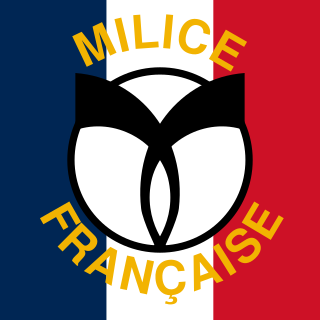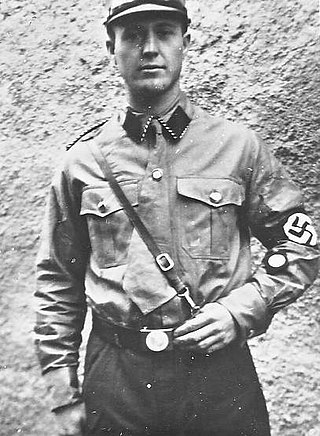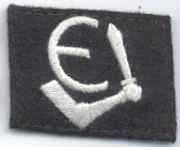
Organisation Todt was a civil and military engineering organisation in Nazi Germany from 1933 to 1945, named for its founder, Fritz Todt, an engineer and senior Nazi. The organisation was responsible for a huge range of engineering projects both in Nazi Germany and in occupied territories from France to the Soviet Union during World War II. It became notorious for using forced labour. From 1943 until 1945 during the late phase of the Third Reich, OT administered all constructions of concentration camps to supply forced labour to industry.

Fritz Todt was a German construction engineer and senior Nazi who rose from the position of Inspector General for German Roadways, in which he directed the construction of the German autobahns (Reichsautobahnen), to become the Reich Minister for Armaments and Ammunition. From that position, he directed the entire German wartime military economy.

The Milice française, generally called la Milice, was a political paramilitary organization created on 30 January 1943 by the Vichy regime to help fight against the French Resistance during World War II. The Milice's formal head was Prime Minister Pierre Laval, although its Chief of operations and de facto leader was Secretary General Joseph Darnand. It participated in summary executions and assassinations, helping to round up Jews and résistants in France for deportation. It was the successor to Darnand's Service d'ordre légionnaire (SOL) militia. The Milice was the Vichy regime's most extreme manifestation of fascism. Ultimately, Darnand envisaged the Milice as a fascist single party political movement for the French state.

The Waffen Grenadier Brigade of the SS Charlemagne was a Waffen-SS unit formed in September 1944 from French collaborationists, many of whom were already serving in various other German units. Named after the 9th-century Frankish emperor, it superseded the existing Legion of French Volunteers Against Bolshevism formed in 1941 within the German Army (Wehrmacht) and the SS-Volunteer Sturmbrigade France formed in July 1943, both of which were disbanded the same month. The division also included French recruits from other German military and paramilitary formations and Miliciens who had fled ahead of the Allied Liberation of France.
Mountain Corps Norway was a German army unit during World War II. It saw action in Norway and Finland.

The Panzer-Lehr-Division was an elite German armoured division during World War II. It was formed in 1943 onwards from training and demonstration troops stationed in Germany, to provide additional armored strength for the anticipated Allied invasion of western Europe. On 4 April 1944, the division was officially designated as the 130th Panzer Division; however, it is usually referred to as the Lehr Division. It was the only Wehrmacht Panzer division to be fully equipped with tanks and with halftracks to transport its mechanized infantry. On several occasions it fought almost to destruction, in particular during Operation Cobra, and by the end of the war in Europe bore little resemblance to the unit that had originally been activated.

The National Socialist Motor Corps was a paramilitary organization of the Nazi Party (NSDAP) that officially existed from May 1931 to 1945. The group was a successor organisation to the older National Socialist Automobile Corps, which had existed since April 1930.

The ranks and insignia of the National Socialist Motor Corps were a paramilitary rank system in Germany used between the years of 1931 and 1945. They were based closely on the ranks and insignia of the Sturmabteilung (SA), of which the NSKK was originally a part.

The Walloon Legion was a unit of the German Army (Wehrmacht) and later of the Waffen-SS recruited among French-speaking collaborationists in German-occupied Belgium during World War II. It was formed in the aftermath of the German invasion of the Soviet Union and fought on the Eastern Front alongside similar formations from other parts of German-occupied Western Europe.

The 20th Waffen Grenadier Division of the SS was a foreign infantry division of the Waffen-SS that served alongside but was never formally part of the Wehrmacht during World War II. According to some sources, the division was under Reichsführer-SS Heinrich Himmler's overall command but was not an integral part of the Schutzstaffel (SS). It was officially activated on 24 January 1944, and many of its soldiers had been members of the Estonian Legion and/or the 3rd Estonian SS Volunteer Brigade, which had been fighting as part of German forces since August 1942 and October 1943 respectively. Both of the preceding formations drew their personnel from German-occupied Estonia. Shortly after its official activation, widespread conscription within Estonia was announced by the German occupying authorities. The division was formed in Estonia around a cadre comprising the 3rd Estonian SS Volunteer Brigade, and was initially known as the 20th Estonian SS Volunteer Division.

The 25th Waffen Grenadier Division of the SS "Hunyadi" was a short-lived infantry division of the Waffen-SS, an armed branch of the German Nazi Party that served alongside but was never formally part of the Wehrmacht during World War II. Established in November 1944 following the German overthrow of the Hungarian regime of Miklós Horthy, it consisted mainly of troops drawn from the Royal Hungarian Army's 13th Honvéd Division. It was never properly formed, trained, or equipped, and after being evacuated from its training camp in the face of the advancing Soviet Red Army, it surrendered to the United States Army in Austria in May 1945.

Adolf Hühnlein was a German soldier and Nazi Party (NSDAP) official. He was the Korpsführer of the National Socialist Motor Corps (NSKK) from 1933 until his death in 1942.

The 30th Infantry Division of the Wehrmacht was created on 1 October 1936 in Lübeck and mobilized on 26 August 1939 for the upcoming invasion of Poland. At that time, it consisted of the usual German infantry division elements: three infantry regiments of three battalions each, one three-battalion regiment of light artillery, one battalion of heavy artillery, a panzerjager (anti-tank) battalion, an aufklärungs (reconnaissance) battalion, a signals battalion, a pioneer (engineer) battalion, and divisional supply, medical, and administrative units.

Franz Xaver Dorsch was a German civil engineer who became the chief engineer of the Organisation Todt (OT), a civil and military engineering group in Nazi Germany that was responsible for a huge range of engineering projects at home and in the territories occupied by the Germans during the Second World War. He played a leading role in many of the Third Reich's biggest engineering projects, including the construction of the Siegfried Line (Westwall), the Atlantic Wall and numerous other fortifications in Germany and occupied Europe. Following the war, he founded the Dorsch Consult consulting engineering company in Wiesbaden.
Luftwaffe construction units were established in 1939 from Reichsarbeitsdienst units transferred to the Luftwaffe, and reinforced with technically competent older conscripts, later also with prisoners of war and foreign volunteers (Hiwis). The main task was the construction and maintenance of military air bases. In 1944 the bulk of the construction units were transferred to the Organization Todt; those remaining under Luftwaffe control becoming Luftwaffe pioneers.
In Nazi Germany, the Standarte was a paramilitary unit of Nazi Party (NSDAP), Sturmabteilung, NSKK, NSFK, and Schutzstaffel (SS). Translated literally as "Regimental standard", the name refers to the flag paramilitary formations carried in formations and parades.
Transportflotte Speer was a government owned waterways transportation company in Nazi Germany. At its creation it was tasked with the transportation of building material on the German inland waterways. During the war, it became subordinated to the Ministry of Armaments, and was given extensive coastal and inland transportation missions in occupied Europe, mainly in the service of Organisation Todt. The company was named after Albert Speer.
Legion Speer was a Nazi German paramilitary motor transportation corps founded in 1942. The members of the Legion were non-German citizens, and as such could not belong to the Nationalsozialistisches Kraftfahrkorps (NSKK). The legion was disbanded in 1944, and its members absorbed into the Transportkorps Speer. It was named after Albert Speer.













